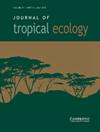Macrotermes termite mounds influence the spatial pattern of tree species in two African rainforest sites, in northern Congo. But were they really forests in the past?
IF 1
4区 环境科学与生态学
Q4 ECOLOGY
引用次数: 1
Abstract
Termite mounds have been poorly studied in tropical rainforest in contrast to those of savannahs where they create fertility hotspots and influence the spatial pattern of vegetation. An inventory of termite mounds and of 15 tree species with a diameter at breast height ≥ 10 cm was carried out in two 800-ha blocks, in two rainforest sites located in northern Congo. We used inhomogeneous and intertype K functions to study the spatial pattern of termite mounds and of tree species around mounds, respectively. We found that mounds in Loundoungou were over-dispersed within a radius of less than 70 m, while those in Mokabi were randomly spaced. Tree species within a 20-m radius around a mound were aggregated towards the mound, e.g. Entandrophragma cylindricum, randomly distributed, or even repulsed by the mound. The specific responses also differed in the two sites. These results suggest that (i) the mounds in Loundoungou were created by savannah termite species 3,000-2,000 years BP during the Late Holocene Rainforest Crisis and (ii) the mounds in Mokabi are characteristic of forest mounds. The impact of termite mounds on the spatial pattern of tree species is thus site-dependent, and these differences might be due to species seed dispersal strategies and to soil calcium concentrations.在刚果北部的两个非洲雨林地区,大型白蚁丘影响着树种的空间格局。但它们真的是过去的森林吗?
与热带草原相比,热带雨林中的白蚁丘研究较少,在热带雨林中,白蚁丘创造了肥沃的热点,并影响了植被的空间格局。在刚果北部的两个雨林地区,对两个800公顷的区块内的白蚁丘和15种直径≥10厘米的树木进行了清查。我们使用非均匀和型间K函数分别研究了白蚁丘和丘周围树种的空间格局。我们发现,Loundoungou的土堆在半径小于70米的范围内过度分散,而Mokabi的土堆则是随机分布的。土丘周围20米半径范围内的树种向土丘聚集,例如圆筒状的Entandorphragma cylindrium,随机分布,甚至被土丘排斥。两个地点的具体反应也有所不同。这些结果表明:(i)Loundoungou的土丘是由3000年至2000年BP的草原白蚁物种在全新世晚期雨林危机期间形成的;(ii)Mokabi的土丘具有森林土丘的特征。因此,白蚁丘对树种空间格局的影响取决于地点,这些差异可能是由于物种种子传播策略和土壤钙浓度造成的。
本文章由计算机程序翻译,如有差异,请以英文原文为准。
求助全文
约1分钟内获得全文
求助全文
来源期刊

Journal of Tropical Ecology
环境科学-生态学
CiteScore
2.10
自引率
0.00%
发文量
44
审稿时长
18-36 weeks
期刊介绍:
Journal of Tropical Ecology aims to address topics of general relevance and significance to tropical ecology. This includes sub-disciplines of ecology, such as conservation biology, evolutionary ecology, marine ecology, microbial ecology, molecular ecology, quantitative ecology, etc. Studies in the field of tropical medicine, specifically where it involves ecological surroundings (e.g., zoonotic or vector-borne disease ecology), are also suitable. We also welcome methods papers, provided that the techniques are well-described and are of broad general utility.
Please keep in mind that studies focused on specific geographic regions or on particular taxa will be better suited to more specialist journals. In order to help the editors make their decision, in your cover letter please address the specific hypothesis your study addresses, and how the results will interest the broad field of tropical ecology. While we will consider purely descriptive studies of outstanding general interest, the case for them should be made in the cover letter.
 求助内容:
求助内容: 应助结果提醒方式:
应助结果提醒方式:


